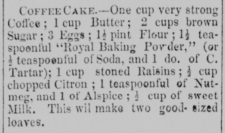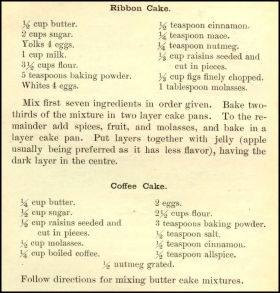That is, a cake with coffee in it. That’s what coffee cake was, for half a century: a spicecake with brewed coffee and raisins (or other fruit, but usually raisins).
Here’s an example from the December 29, 1877 edition of The Iola (Kansas) Register:
|
Coffee Cake. — 1 cup strong coffee, 1 cup of sugar, 1 cup molasses, 1 teaspoonful soda, 1 cup butter, 4 cups flour, 1 pound fruit.
|
Here’s one from the July 10, 1878 edition of the Woodstock, Virginia Shenandoah Herald:
|
Coffee Cake. — One cup very strong Coffee; 1 cup Butter; 2 cups brown Sugar; 3 eggs; 1-1/2 pint Flour; 1-1/2 teaspoonful “Royal Baking Powder,” (or 1/2 teaspoonful of Soda, and 1 do. of C. Tartar); 1 cup stoned Raisins; 1/2 cup chopped Citron; 1 teaspoonful of Nutmeg, and 1 of Allspice; 1/2 cup of sweet Milk. This will make two good-sized loaves.
|
(Note that “do.” in the above context means “ditto,” or in other words, 1 teaspoonful.)
So what’s going on here? Well, we had coffee a lot earlier than we had what we currently describe as coffee cake.
The Dutch brought coffee to New Amsterdam in the 17th century, and colonists visited coffeehouses just as Europeans did. As we expanded out West in the first half of the 19th century, coffee was an essential part of frontier living, even though you generally had to crush the beans by hand and would frequently drink it unfiltered, letting the grit settle. (If you were too fussy to do that, you probably shouldn’t be on the frontier).
The camp cooks traveling with the Conestoga wagons weren’t about to throw anything out, if they could help it; it’s likely that coffee replaced milk in some cakes or cobblers, though they didn’t exactly stop to make cookbooks. Either way, recipes did start appearing in newspapers around the 1850s.
Meanwhile, the foundation for the coffee cake we recognize–German immigration–was starting to pick up. We’ve already talked about kuchen, the forerunner of modern coffee cake, in the post for German kuchen.
After German revolutions failed to produce democracy in 1849, a wave of immigrants brought German culture to the Midwest. In the 1870s, a Tsarist Russian revocation of farming rights to German immigrants brought more to the frontier, where the farmers picked up where they left off. By 1890, 2.8 million German-born Americans lived in the U.S.
At first, coffee cake and kuchen peacefully coexisted. Between the late 1890s and early 1920s, coffee cake slowly evolved to become more kuchen-like.
The textbooks of the Boston Cooking School, founded in 1879, reflected this evolution. Compare the coffee cake recipe in the 1886 version of their cookbook to the same recipe in the 1897 version of (though the latter retained a stronger version, now named “Rich Coffee Cake”):
|
1886: D.A. Lincoln’s
Boston Cook Book |
1897: F.M. Farmer’s Boston
Cooking-School Cook Book |
| Calls for 1 cup of coffee to 3.5 cups flour, a ratio of 1:3.5 | Calls for 1/4 cup of coffee to 2.5 cups flour, a ratio of 1:10 |
|
Ribbon Cake
1 cup butter Have three long, shallow pans, of equal size. Divide the dough into three parts. Bake two parts as plain cake; add to the remaining dough, 1/2 cup raisins, stoned and chopped Bake, and put the fruit cake between the two plain cakes, with jelly between. Press it lightly with the hand in putting together; trim the edges even, and frost.
Coffee Cake
Use one cup of strong, clear coffee instead of milk and make as in the preceding rule. Add the fruit and spices to the whole mixture. Bake it in one loaf. |
Ribbon Cake
1/2 cup butter Mix first seven ingredients in order given. Bake two-thirds of the mixture in two layer cake pans. To the remainder add spices, fruit, and molasses, and bake in a layer cake pan. Put layers together with jelly (apple usually being preferred as it has less flavor), having the dark layer in the center.
Coffee Cake
1/4 cup butter Follow directions for mixing butter cake mixtures. |
By about 1910, coffee cake generally meant some variety of kuchen, unless you clarified otherwise, and the original spiced cakes with coffee and raisins were left in the back of recipe boxes.
From the box of A.D. from Lutz, Florida, by way of Pennsylvania in the 1940s, and originating in Ohio in the 1920s.
Coffee Cake
1 cup brown sugar
1 cup molasses made of sugar
1/2 cup butter
1 cup strong coffee
1 egg or two yolks
4 even cups of flour
1 heaping tsp. baking soda
1 heaping tsp. cinnamon
1 heaping tsp. cloves
1 cup of raisins.
Bake in loaf.





